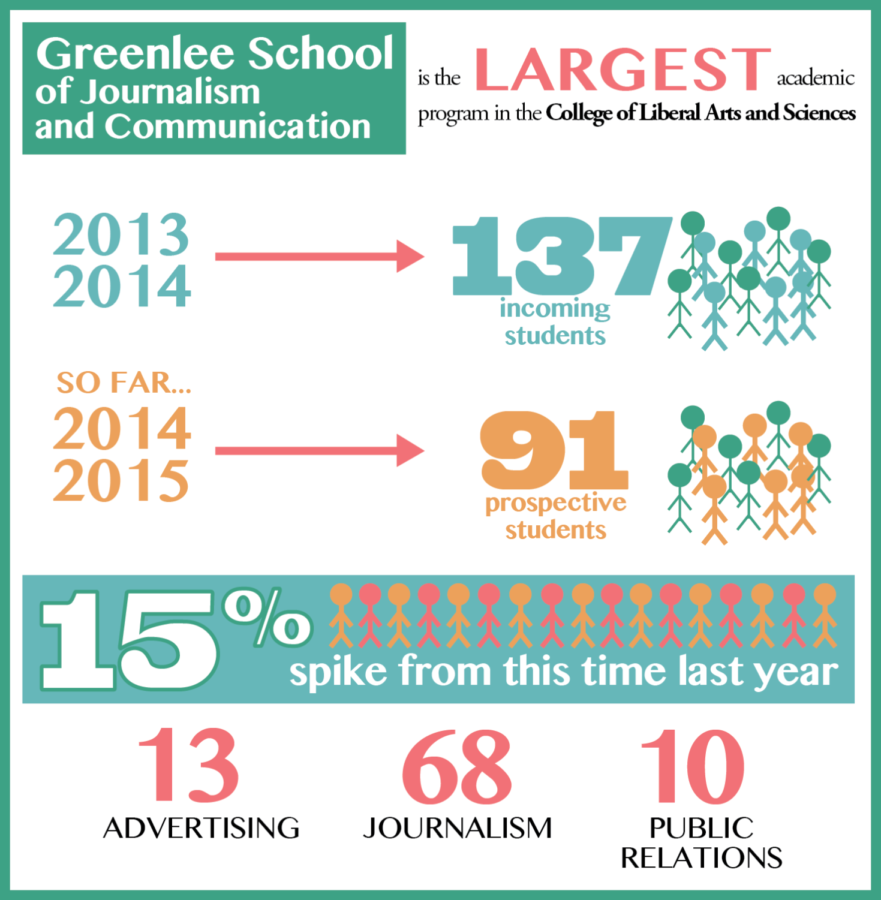Greenlee enrollment spikes with public relations major, focus on avoiding student debt
As the largest academic program in the College of Liberal Arts and Sciences, the prospective student enrollment at the Greenlee School of Journalism and Communication is at a 15 percent increase from March 2013 to March 2014.
March 28, 2014
The Greenlee School of Journalism has had a 15 percent increase in student accepts since this time last year, due largely to the recently added public relations major and the school’s focus on avoiding student debt.
Both journalism and mass communication and advertising have had two years of near record-breaking enrollment with 721 students currently in the school. About 120 of those make up the new public relations major. So far, Greenlee has 91 incoming students for next year. This number is only surpassed by the School of Computer Science at 135 and psychology at 100 incoming students.
That is an increase in students compared to fall 2013, which had a total of 605 students — 409 in journalism and 196 in advertising.
Originally approved in fall 2013, the public relations major became popular quickly but did not affect the other two majors within the school.
“People who are coming into the school to take public relations are coming into that degree. Our journalism numbers are as strong as ever; our advertising numbers are as strong as ever,” said Michael Bugeja, director of the Greenlee School.
The major was brought in because of the interest in public relations as a career and the Greenlee School having all the required courses to have the major.
“We have always taught public relations in the school,” Bugeja said. “[It] only seemed natural to go for a degree so that students who want that profession can have a degree showing it.”
Erin Wilgenbusch, senior lecturer and the Public Relations Student Society of America adviser, explained how advertising the major was easy since the school already offered all the courses and how it got a lot of attraction from current and incoming students.
“We’re putting a name to something we’re already doing,” Wilgenbusch said. “That’s a lot easier to market.”
Making the major did not come easy, though, as the school could not accredit the program through the student society because they did not track what students were interested in a public relations career field. Because of that, Greenlee approached the program with making it into a major.
“We have a very active award-winning Public Relation Student Society of America chapter at Iowa State University,” Bugeja said. “We also have a curriculum in public relations that rivals any other degree program. So in other words, we had the courses already, so why not if we can get accredited for public relations by the Public Relations Society of America.”
There was a fear initially that the new major would take away journalism and advertising students, but Wilgenbusch explained why the results said otherwise, saying those who go into journalism and advertising go in it for that major and those who go into public relations will go for that major.
“I think it’s always been that way. I think it’s a mind-set people come in with,” Wilgenbusch said. “I think people already knew, and at first there’s that panic that we would take all the journalism students but people knew what they want when they came here.”
Beyond the new major, Bugeja said the school can also thank its graduation plan for students as a factor. The school concentrates on ensuring students graduate in four years, and the school is known for its 97 percent employment rate with students getting jobs within six months of graduation.
“We make sure that the parents know that we push through with as little debt as possible,” Bugeja said. “That’s been a big draw.”
Bugeja hopes to continue getting more students within the school and all of its majors, but he stresses the official number of students cannot be revealed until June 1.
“Word of mouth has been spreading … We can recruit as many people as we want,” Bugeja said.
Wilgenbusch said the large number of newer students coming in will not take away from the Greenlee promise either. The classes will remain at a smaller size but will contain more sections to fill requirements for Greenlee’s skills courses.
“If it got to the point where we had to have multiple sections, I think students will have that nice, small classroom environment just with more sections,” Wilgenbusch said.
“We are working on ways to find new lab space,” Bugeja said. “Those decisions, however, have not been made.”
Bugeja explained that Greenlee students’ tuition will be used to get more labs and proper expansion to respond to the increasing number of students.

















